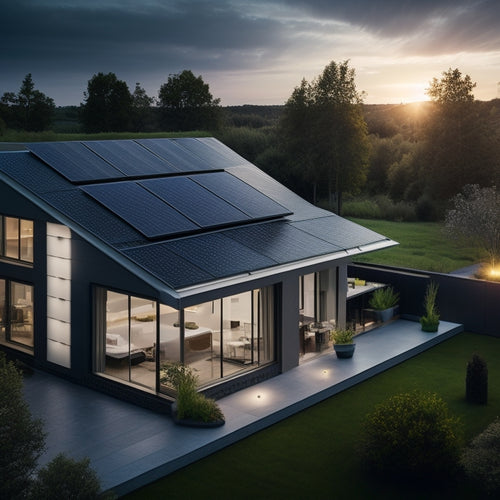
Price of One Solar Panel
Share
You can expect to pay between $200 to $500 for a single high-efficiency solar panel, depending on the wattage, brand, and quality. With advancements in technology, monocrystalline silicon cells have become more efficient, providing higher conversion rates and increased max power output. This means you'll generate more energy from each panel, leading to significant cost savings and a reduced carbon footprint. When selecting a panel, consider your roof size, warranty guarantee, and installation considerations to maximize energy output and savings. As you investigate solar panel options, you'll realize how these factors impact the overall value of your investment.
The Essentials
- The price of one solar panel varies depending on its wattage, efficiency, and brand, ranging from $200 to $1,000 or more.
- Higher efficiency solar panels with higher wattage ratings tend to be more expensive, but they can generate more electricity per unit area.
- Monocrystalline solar panels are typically more expensive than polycrystalline ones, but they offer higher efficiency rates and more power output.
- The cost of a single solar panel is a small fraction of the total cost of a solar panel system, which includes installation, inverters, and mounting hardware.
- Government incentives, subsidies, and economies of scale in manufacturing can help reduce the cost of solar panels, making them more affordable for consumers.
Higher Energy Efficiency Guaranteed
You'll benefit from higher conversion rates with advanced solar panels, which directly translate to more energy harvested from the same amount of sunlight.
This means you can expect max power output from each panel, leading to a significant increase in your overall energy production.
By achieving grid parity, you'll be able to generate electricity at a lower cost than traditional fossil fuels.
With these efficiency gains, you'll be able to generate more power while reducing your environmental footprint.
Higher Conversion Rates
Most solar panels on the market today boast conversion rates between 15% and 20%, with top-tier models reaching efficiencies of up to 22%. As you investigate the options, you'll notice that higher conversion rates translate to more energy harvested from the same surface area. This means you can generate more power with fewer panels, reducing your overall installation costs.
| Solar Panel Type | Conversion Rate |
|---|---|
| Standard Efficiency | 15% - 17% |
| High Efficiency | 18% - 20% |
| Premium Efficiency | 21% - 22% |
| Bifacial Panels | 22% - 24% |
The latest advancements in solar technology have led to significant improvements in energy conversion rates. As energy trends continue to shift towards renewable sources, you can expect even higher efficiencies in the future. When choosing a solar panel, look for models with higher conversion rates to maximize your energy output. This will not only reduce your carbon footprint but also increase your energy independence.
Max Power Output
Higher conversion rates directly impact a solar panel's max power output, which is the maximum amount of energy it can produce under ideal conditions. You should know that a higher max power output means you'll generate more electricity from the same amount of sunlight. This, in turn, reduces your reliance on the grid and minimizes your energy bills.
With integrated photovoltaic systems and power storage, you can guarantee a reliable source of renewable energy for your home or outdoor excursions renewable energy solutions. Additionally, a higher max power output can also provide a backup power source that can keep you connected and your essential devices running during unexpected outages and emergencies.
When evaluating a solar panel's max power output, consider the wattage (W) rating. A higher wattage rating indicates a higher max power output. For instance, a 300W solar panel will produce more energy than a 250W panel under the same conditions.
Max power output also affects panel lifespan, as a higher output can lead to increased heat generation, potentially reducing the panel's lifespan.
Keep in mind that higher max power output often comes at a higher cost. You'll need to weigh the benefits of increased energy production against the added installation costs.
Reduces Carbon Footprint Significantly
You'll considerably reduce your carbon footprint by switching to solar energy, which directly translates to a lower emissions output.
This reduction is largely due to your decreased reliance on fossil fuels, a major contributor to greenhouse gas emissions. By using solar power, you'll be producing clean energy that doesn't harm the environment.
Additionally, with residential solar energy systems, you can reduce your energy bills and connect to the electrical grid electrical grid connection, further minimizing your impact on the environment.
Lower Emissions Output
A solar panel's lower emissions output reduces your carbon footprint greatly, making it an attractive option for environmentally conscious individuals. By choosing solar energy, you're contributing to emission reduction, which is essential in the fight against climate change.
Traditional energy sources, such as fossil fuels, release massive amounts of greenhouse gases into the atmosphere, leading to environmental degradation. In contrast, solar panels produce clean energy, relying on sunlight as their primary source.
When you install a solar panel, you're investing in sustainable energy and markedly decreasing your reliance on non-renewable resources. This shift towards cleaner energy production not only benefits the environment but also enhances energy independence.
With solar panels, you're generating power locally, reducing your dependence on the grid and minimizing the need for lengthy transmission lines. By adopting solar energy, you're taking an important step towards a more sustainable future, characterized by reduced emissions and a cleaner environment.
Reduce Fossil Fuel Usage
Solar panels reduce your reliance on fossil fuels, greatly decreasing your carbon footprint. By installing solar panels, you're taking a significant step towards reducing your dependence on non-renewable energy sources.
This, in turn, leads to a substantial decrease in greenhouse gas emissions, contributing to a cleaner environment.
As you shift to solar energy, you'll notice a reduction in your energy bills. This is because solar panels generate electricity locally, reducing your need for grid-supplied power.
Furthermore, many governments offer solar policy incentives and energy subsidies to encourage individuals and businesses to adopt renewable energy sources. These incentives can help offset the initial investment costs of installing solar panels.
Monocrystalline Silicon Cells
You'll find that monocrystalline silicon cells offer high efficiency rates, typically ranging from 15% to 20%, which is considerably higher than other types of solar cells.
This higher efficiency translates to more power output per unit area, making them a popular choice for solar panels, especially for those looking to maximize energy savings and reduce their carbon footprint.
As you investigate monocrystalline silicon cells further, you'll also uncover that their production costs are lower compared to other high-efficiency options.
High Efficiency Rates
Within the domain of photovoltaic cells, monocrystalline silicon cells have emerged as a paragon of high efficiency rates. You'll find that these cells boast an impressive efficiency rate of up to 22.8%, markedly outperforming their polycrystalline counterparts. This superior performance is attributed to the single-crystal structure, which enables better electron flow and reduced recombination losses.
When it comes to solar technology, monocrystalline silicon cells are the gold standard. In an efficiency comparison, they consistently outrank other types of solar cells. This is particularly evident in their ability to convert sunlight into electricity, even in low-light conditions.
You can expect a higher power output from a monocrystalline solar panel, making them an attractive option for those seeking to maximize their renewable energy generation.
As you investigate the world of solar energy, you'll find that high-efficiency rates are essential for optimizing your energy yield. With monocrystalline silicon cells, you can rest assured that you're getting the most out of your solar panel investment.
Lower Production Costs
Every additional percentage point of efficiency in monocrystalline silicon cells translates to a significant reduction in production costs. This means you can benefit from lower prices without compromising on quality.
The key driver behind this cost reduction is the streamlining of manufacturing processes. You see, manufacturing innovations have led to the development of more efficient production lines, reducing waste and energy consumption. As a result, the cost of producing monocrystalline silicon cells has decreased dramatically.
For instance, advances in wafer cutting and cell processing have minimized material losses, further reducing costs. Additionally, the implementation of automation and robotics has increased productivity while lowering labor costs.
All these factors combined have led to a significant cost reduction in the production of monocrystalline silicon cells. This, in turn, has made solar panels more affordable and accessible to you, the consumer.
With lower production costs, you can now enjoy the freedom to generate your own clean energy without breaking the bank.
Check Your Roof Size
You'll need to accurately measure your roof to determine how many solar panels you can fit. To do this, take precise measurements of your roof's length, width, and any obstructions like skylights or vents.
When considering residential solar panels, it's crucial to assess your energy needs and evaluate the available roof space. You can then use a roof size calculator to translate these measurements into a usable area for solar panels.
Roof Measurement Tips
By virtue of its impact on solar panel installation, accurate roof measurement is vital. You'll want to guarantee you're getting precise measurements to maximize your solar panel's energy output.
Start by identifying any obstructions that may cause roof shading, such as chimneys, vents, or skylights. Take note of their location and size to determine the best panel orientation for peak energy production.
When measuring your roof, consider the size and shape of each section. Measure the length, width, and pitch of each section, as well as any obstacles like roof valleys or dormers. Record these measurements to determine the total available space for your solar panels.
Keep in mind that panel orientation is critical for energy production. You'll want to position your panels to face directly at the sun, factoring in any potential shading from surrounding structures or trees.
Roof Size Calculator
Accurate roof measurements are critical to determining the ideal placement and number of solar panels for your installation. To guarantee a precise calculation, you'll need to gather your roof's dimensions, including its length, width, and pitch.
A roof size calculator can simplify this process by providing a step-by-step guide to inputting your roof's specifics.
When using a roof size calculator, you'll typically be asked to input your roof's dimensions, including the number of squares, hips, and valleys. This information will help the calculator determine the total usable roof area, considering obstacles like skylights, vents, and chimneys.
The calculator will then provide you with installation guidelines, including the best solar panel layout and the number of panels required to meet your energy needs.
5-Year Warranty Guarantee
When you're shopping for a solar panel, you'll want to evaluate the year warranty guarantee, which directly impacts reliable panel performance.
A longer warranty period typically indicates a manufacturer's confidence in their product's ability to perform consistently over time.
You should look for a warranty that covers at least 25 years of performance, ensuring your investment yields the expected returns.
Reliable Panel Performance
Your solar panel's reliable performance is essential to maximizing its energy output and return on investment. A well-performing solar panel guarantees you generate the most electricity possible, reducing your reliance on the grid and saving you money on your energy bills.
You want a solar panel that will last for decades, not just years. That's why panel longevity is critical. Look for a panel with a proven track record of durability and resistance to degradation. A high-quality panel will retain its energy output over time, even in harsh environmental conditions.
The installation quality also plays a significant role in your panel's performance. A poorly installed panel can lead to reduced energy output, safety hazards, and even system failure.
Confirm your installation team has the necessary proficiency and follows industry best practices to assure a reliable and efficient system. With a reliable solar panel and proper installation, you can enjoy the freedom and independence that comes with generating your own clean energy.
Frequently Asked Questions
Can I Install Solar Panels on a Metal or Tile Roof?
You can install solar panels on a metal or tile roof, but you'll face unique installation challenges. Verify roof compatibility by choosing the right mounting system and evaluating your roof's structural integrity to confirm a secure and efficient installation.
Are Solar Panels Resistant to Extreme Weather Conditions?
You'll be surprised to know that solar panels are incredibly resilient, withstanding extreme temperatures from -40°C to 85°C, resisting hail damage up to 25mm, and boasting wind resistance of up to 2400 Pa; they even shed snow accumulation efficiently.
What Maintenance Is Required for Solar Panels?
You'll need to perform regular cleaning techniques, like soft-brush sweeping and hose rinsing, to guarantee ideal energy harvesting; also, monitor performance metrics to identify potential issues, making certain your solar panels operate at peak efficiency.
Can I Install Solar Panels Myself or Diy?
You're part of the 70% of Americans considering solar power; now, can you DIY install solar panels? While it's possible, hiring a pro guarantees peak performance, maximizing the benefits of solar energy, like reduced carbon footprint and energy independence.
Do Solar Panels Work During Power Outages?
When you're wondering if solar panels work during power outages, here's the deal: they typically don't, unless you've got a battery backup system; in that case, you'll have solar panel functionality and a reliable power outage solution, giving you freedom from the grid.
Final Thoughts
You've made a smart investment by considering the price of one solar panel. Now, you're on the cusp of utilizing renewable energy and reducing your carbon footprint. Remember, the proof is in the pudding - higher energy efficiency and a 5-year warranty guarantee are just the beginning. With monocrystalline silicon cells, you're set to reap the benefits of clean energy. So, take the leap and join the solar revolution - your wallet and the planet will thank you.
Related Posts
-

How to Achieve a Zero-Waste Lifestyle for a Greener Tomorrow
To achieve a zero-waste lifestyle, start by adopting the principles of refusing, reducing, reusing, and recycling. Sw...
-

Solar Powered Lights for Sustainable Home Decor
Solar-powered lights offer a stylish and eco-friendly way to enhance your home decor. They capture sunlight, converti...
-

Home Solar Battery
You're opting for a home solar battery that allows you to utilize the power of the sun during the day and use it at n...


